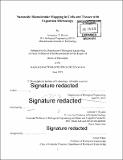| dc.contributor.advisor | Edward S. Boyden. | en_US |
| dc.contributor.author | Wassie, Asmamaw T. | en_US |
| dc.contributor.other | Massachusetts Institute of Technology. Department of Biological Engineering. | en_US |
| dc.date.accessioned | 2019-11-22T00:09:40Z | |
| dc.date.available | 2019-11-22T00:09:40Z | |
| dc.date.issued | 2019 | en_US |
| dc.identifier.uri | https://hdl.handle.net/1721.1/123069 | |
| dc.description | Thesis: Ph. D., Massachusetts Institute of Technology, Department of Biological Engineering, 2019 | en_US |
| dc.description | Cataloged from PDF version of thesis. "June 2019." | en_US |
| dc.description | Includes bibliographical references. | en_US |
| dc.description.abstract | The ability to map the molecular organization of cells and tissues with nanoscale precision would open the door to understanding their biological functions as well as the mechanisms that lead to pathologies. Though recent technological advances have expanded the repertoire of biological tools, this crucial ability remains an unmet need. Expansion Microscopy (ExM) enables the 3D, nanoscale imaging of biological structures by physically magnifying cells and tissues. Specimens, embedded in a swellable hydrogel, undergo uniform expansion as covalently anchored labels and tags are isotropically separated. ExM thereby allows for the inexpensive nanoscale imaging of biological samples on conventional light microscopes. In this thesis, I describe the development of a method called Expansion FISH (ExFISH) that uses ExM to enable the nanoscale imaging of RNA throughout cells and tissues. A novel chemical approach covalently retains endogenous RNA molecules in the ExM hydrogel. After expansion, RNA molecules can be interrogated with in situ hybridization. ExFISH opens the door for the investigation of the nanoscale organization of RNA molecules in various contexts. Applied to the brain, ExFISH allows for the precise localization of RNA in nanoscale neuronal compartments such as dendrites and spines. Furthermore, the optical homogeneity of expanded samples enables the imaging of RNA in thick tissue-sections. ExFISH also supports multiplexed imaging of RNA as well as signal amplification techniques. Finally, this thesis describes strategies for the multiplexed characterization of biological specimens. Taken together, these approaches will find applications in developing an integrative understanding of cellular and tissue biology. | en_US |
| dc.description.statementofresponsibility | by Asmamaw T. Wassie. | en_US |
| dc.format.extent | 102 pages | en_US |
| dc.language.iso | eng | en_US |
| dc.publisher | Massachusetts Institute of Technology | en_US |
| dc.rights | MIT theses are protected by copyright. They may be viewed, downloaded, or printed from this source but further reproduction or distribution in any format is prohibited without written permission. | en_US |
| dc.rights.uri | http://dspace.mit.edu/handle/1721.1/7582 | en_US |
| dc.subject | Biological Engineering. | en_US |
| dc.title | Nanoscale biomolecular mapping in cells and tissues with expansion microscopy | en_US |
| dc.type | Thesis | en_US |
| dc.description.degree | Ph. D. | en_US |
| dc.contributor.department | Massachusetts Institute of Technology. Department of Biological Engineering | en_US |
| dc.identifier.oclc | 1127385376 | en_US |
| dc.description.collection | Ph.D. Massachusetts Institute of Technology, Department of Biological Engineering | en_US |
| dspace.imported | 2019-11-22T00:09:39Z | en_US |
| mit.thesis.degree | Doctoral | en_US |
| mit.thesis.department | BioEng | en_US |
